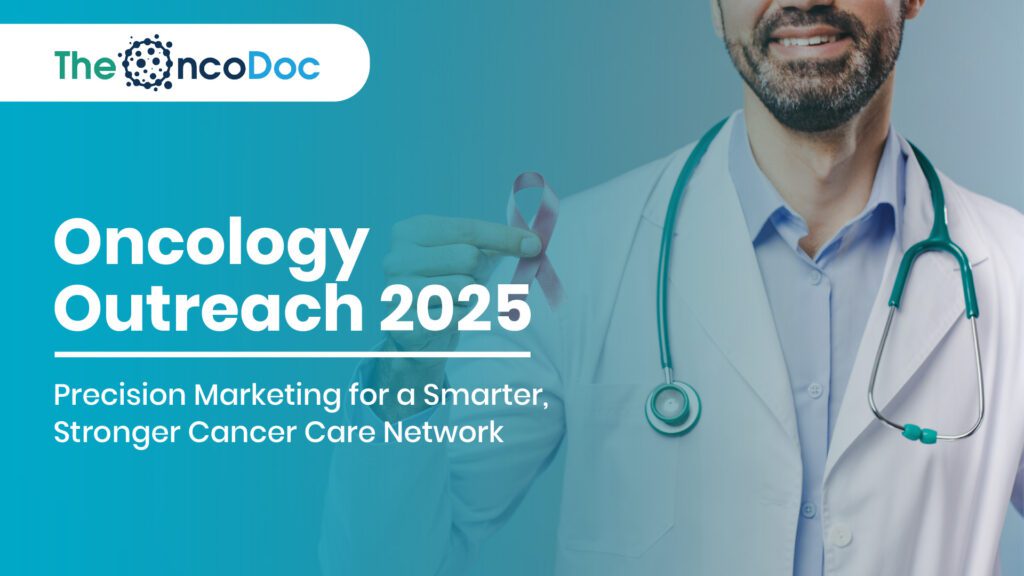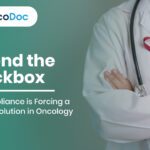Introduction: The New Era of Pharma-Oncology Partnerships
In 2025, oncology marketing has shifted from being a transactional exchange between pharma companies and oncologists to becoming a highly coordinated ecosystem of trust, data fluency, and patient engagement. The old playbook—mass promotional campaigns and generic conference booths—has given way to a targeted, analytics-driven approach that focuses on measurable patient outcomes.
The industry’s transformation is fueled by three converging forces:
- The explosion of precision oncology therapies that demand equally precise communication.
- The adoption of AI and predictive analytics that allow campaigns to anticipate needs before they arise.
- The rise of patient-centric and GP-integrated care models that require pharma brands to support entire care journeys, not just prescribe drugs.
This article explores how pharma companies are evolving their oncology marketing strategies, with actionable insights and technology-driven tactics that connect innovation with real-world patient benefit.
1. From Product Pitches to Care Pathway Integration
Five years ago, pharma marketing in oncology largely focused on product efficacy and safety profiles. While these remain essential, the conversation in 2025 is increasingly about how a therapy fits into an entire patient care pathway—from symptom recognition to survivorship support.
Pharma companies now create content that:
- Educates oncologists on where the drug fits into updated NCCN or ESMO guidelines.
- Provides fast-reference diagnostic checklists to help GPs and nurse practitioners.
- Gives patients reasonable expectations by outlining care timetables in straightforward terms.
By positioning themselves as navigators of the full cancer care journey, brands are seen as trusted allies rather than transaction-driven vendors.
2. Data-Optimized Segmentation in Oncology
Campaigns in 2025 mostly concentrate on micro-segmentation because cancer trends vary significantly between populations and geographical areas.
Instead of dividing audiences only by cancer type, pharma marketers segment by:
- Digital behavior (search terms, online symptom checker usage).
- Socioeconomic obstacles (insurance coverage, access to specialized centers).
- Cultural preferences (trust in community healers, local languages).
AI-driven platforms integrate epidemiological data with anonymized EHR analytics to tailor outreach. This ensures an ad for an advanced lung cancer therapy reaches exactly the subset of oncologists who are treating late-stage patients in regions with high tobacco exposure rates.
3. GP Engagement as the First Line of Oncology Marketing
General practitioners are still the critical referral gatekeepers in oncology. Early engagement here means earlier diagnosis, which directly impacts survival rates and therapy adoption.
Pharma brands now deliver GP-focused initiatives like:
- Red flag cancer signs are explained in microlearning films that last less than three minutes.
- WhatsApp-based CME quizzes that grant instant certificates.
- Referral toolkits with printable patient awareness posters.
4. Omnichannel Personalization
Where oncologists once preferred conference booths and peer-review journals, today they expect seamless, personalized content across multiple touchpoints. This includes:
- Email summaries of the latest trial data.
- Push notifications through secure oncology apps.
- Social media snippets that translate trial outcomes into quick visual charts.
- Patient case study videos that show therapy outcomes in real time.
The consistency of messaging across channels builds brand recall and ensures oncologists receive relevant content no matter their preferred platform.
5. Emotional Storytelling as a Trust Catalyst
Emotions remain a powerful lever in oncology marketing. Survivor narratives, family perspectives, and GP testimonials resonate more deeply than raw numbers.
The most effective campaigns in 2025:
- Pair statistical impact with a real patient’s face and voice.
- Use short-form documentary clips to showcase full recovery journeys.
- Translate survivor stories into multiple languages for broader cultural impact.
6. AI Predictive Outreach for Cancer Hotspots
AI is no longer just a research tool—it’s a marketing compass. By analyzing local search queries, hospital admission patterns, and even social media chatter, AI platforms can flag emerging cancer hotspots.
Example: If a surge in “persistent cough” searches aligns with hospital outpatient data in a rural district, a pharma company can:
- Deploy awareness ads targeting that district’s GPs.
- Sponsor mobile screening units in high-risk zones.
- Equip oncologists with early-detection brochures relevant to that community.
7. Key Triggers That Influence Early Screening
A deep understanding of what motivates patients to get screened is central to effective campaign design. Pharma-sponsored studies in 2025 show that personal narratives and professional advice far outweigh generic advertisements.
8. Vernacular and Cultural Campaigns
Cancer awareness success depends on cultural resonance. A rural audience in Northern India will be much more interested in a Hindi explainer video about cervical cancer prevention than in one with English subtitles.
In 2025, pharma marketers are:
- Collaborating with regional media houses for local radio jingles.
- Sponsoring folk theater scripts that integrate cancer awareness themes.
- Creating QR-linked pamphlets in local languages for village health centers.
9. Building Clinical Resource Hubs for Oncologists
To be seen as knowledge partners, pharma brands now invest in dedicated digital hubs that:
- Combine trial data according to the stage and kind of cancer.
- Provide downloadable patient education sheets.
- Host private discussion boards for oncologists to share case insights.
These hubs often integrate CME tracking so physicians earn credits while accessing resources.
10. Measuring What Matters: New Oncology Marketing KPIs
The shift from vanity metrics to impact metrics means marketers are now held accountable for health outcomes their campaigns influence.
11. Collaborating with Micro-Influencers in Healthcare
Rather than chasing big-name national oncologists for endorsements, brands are partnering with regional opinion leaders who:
- Have deeper trust within local medical networks.
- Are active in community medical boards.
- Can speak the vernacular fluently.
These micro-influencers are often the ones attending local CME events and interacting with patients daily, giving them a stronger grassroots impact. Partnering with them also ensures campaigns feel more authentic and less corporate, which significantly improves receptivity.
12. Gamification in Cancer Awareness
Gamification is entering oncology awareness through:
- Screening challenges between hospital networks.
- Digital “health points” earned by patients for attending check-ups.
- Leaderboards in community health apps.
The friendly competitive element keeps communities engaged and motivated to prioritize health screenings. By framing prevention as an achievable goal rather than a chore, participation rates can rise dramatically within months.
13. Integrating Wearables into Oncology Campaigns
Wearable devices now feed into pharma engagement platforms, alerting users when certain metrics (weight loss, irregular heart rate) deviate from healthy ranges.
In oncology marketing, wearables:
- Trigger awareness notifications.
- Sync with cancer symptom-tracking apps.
- Offer incentives for regular check-ups.
By combining biometric data with predictive algorithms, campaigns can deliver hyper-personalized nudges. This converts the wearable from a passive tracker into an active health companion.
14. Government and NGO Partnership Models
Impact and credibility are increased by strategic partnerships with NGOs and government health agencies. Joint initiatives include:
- Co-branded awareness weeks.
- State-funded mobile screening drives.
- Training programs for ASHA workers using pharma-developed kits.
Such partnerships also help in navigating regulatory landscapes more effectively. When public and private health sectors join forces, the reach and sustainability of cancer prevention programs improve exponentially.
15. Virtual Patient Support Networks
Patient support groups have migrated online into moderated communities where:
- Oncologists host Q&A livestreams.
- Survivors mentor newly diagnosed patients.
- Pharma brands offer wellness program sponsorships.
These groups help reduce the sense of isolation that often comes with a cancer diagnosis. They also create long-term engagement channels where brand presence becomes associated with care and support.
16. Voice-Tech and Accessibility in Outreach
With rising smartphone penetration in rural India and Africa, voice-based awareness tools are expanding reach to low-literacy populations.
Examples include:
- IVR hotlines in multiple languages.
- Voice bots answering common cancer FAQs.
- Smart speaker cancer awareness modules for clinics.
Voice-based tools break literacy barriers, allowing health information to reach previously excluded groups. The human-like interaction also fosters greater trust and comprehension among first-time users.
17. Real-Time Sentiment Feedback Loops
AI-driven sentiment monitoring scans digital conversations and patient forums to measure how campaigns are received. This enables mid-campaign adjustments to avoid fear-driven drop-offs.
Brands are now able to detect tone shifts in real time and address them before they snowball into misinformation or distrust. This agility keeps campaigns both accurate and emotionally resonant.
18. Survivor-Led Community Engagement Programs
Survivor ambassadors conduct workplace health talks, school awareness sessions, and community rallies—activities often sponsored by pharma companies but executed by survivors for authenticity.
This approach taps into the undeniable credibility of lived experience. When survivors share how early detection or timely treatment saved their lives, the impact is both emotional and actionable.
19. Augmented and Virtual Reality in Clinical Education
AR/VR now powers oncology CME programs that:
- Demonstrate drug mechanism of action in 3D tumor environments.
- Allow immersive tumor board simulations.
- To evaluate experiment data, provide virtual “lab walkthroughs.”
Such immersive tools make complex oncology concepts easier to grasp, even for busy specialists. They also allow remote learning, ensuring equitable access to high-quality education regardless of location.
20. Chatbot-Driven Pre-Screening
Smart oncology chatbots triage patient concerns before hospital visits, improving workflow efficiency and aligning patients with the right specialist faster.
Their 24/7 availability means that even late-night health anxieties can be addressed instantly. This rapid response can reduce delays in diagnosis and improve treatment initiation rates.
21. Social Listening for Misinformation Control
Brands use AI to detect and counter myths—such as “herbal cures” or “radiation causes cancer spread”—within hours of trending.
By deploying fact-checking content at the right time, campaigns prevent misinformation from gaining momentum. This proactive stance also reinforces the brand as a reliable source of medical truth.
22. Post-Treatment Support as a Marketing Asset
Pharma-run survivorship programs now include:
- Nutritional rehabilitation guides.
- Exercise trackers tailored to recovery.
- Psychological counseling webinars.
This continued involvement reassures patients that the brand’s commitment extends beyond the treatment phase. It also positions the brand as a holistic healthcare partner rather than just a medication provider.
Conclusion: The Road Ahead
The oncology marketing of 2025 is built on precision, empathy, and measurable outcomes. Success lies in anticipating needs, integrating into care pathways, and delivering value beyond the prescription pad. As AI, cultural intelligence, and patient-centered ecosystems mature, pharma companies that combine technological foresight with authentic human connection will define the gold standard for oncology engagement.
In the years ahead, the competitive advantage will belong to brands that view marketing as a form of healthcare delivery. By embedding themselves into every meaningful touchpoint of the cancer journey, these companies will not only grow market share but also save lives.
The Oncodoc team is a group of passionate healthcare and marketing professionals dedicated to delivering accurate, engaging, and impactful content. With expertise across medical research, digital strategy, and clinical communication, the team focuses on empowering healthcare professionals and patients alike. Through evidence-based insights and innovative storytelling, Hidoc aims to bridge the gap between medicine and digital engagement, promoting wellness and informed decision-making.



